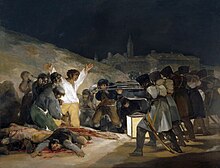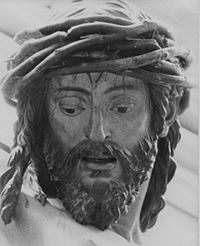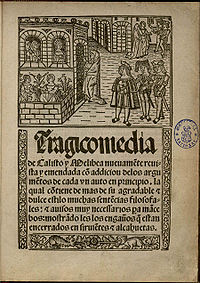Spanish art
Spanish art is an important and influential type of art in Europe. Spanish art is the name given to the artistic disciplines and works developed in Spain throughout time, and those by Spanish authors world-wide. Due to historic, geographic and generational diversity, Spanish art has known a great number of influences. The Moorish heritage in Spain, especially in Andalucia is still evident today in cities like Córdoba, Sevilla, and Granada. European influences include Italy and France, especially during the Baroque and Neoclassical periods.
Painting

Baroque
Diego Velázquez (1599-1660), was a Spanish painter, the leading artist in the court of King Philip IV. He was an individualistic artist of the contemporary baroque period, important as a portrait artist. In addition to numerous renditions of scenes of historical and cultural significance, he created scores of portraits of the Spanish royal family, other notable European figures, and commoners. In many portraits, Velázquez gave a dignified quality to less fortunate members of society like beggars and dwarfs. In contrast to these portraits, the gods and goddesses of Velázquez tend to be portrayed as common people, without divine characteristics. Besides the forty portraits of Philip by Velázquez, he painted portraits of other members of the royal family, including princes, infantas (princesses), and queens.

Francisco Goya was a portraitist and court painter to the Spanish Crown, a chronicler of history, and, in his unofficial work, a revolutionary and a visionary. Goya painted the Spanish royal family, including Charles IV of Spain and Ferdinand VII. His themes range from merry festivals for tapestry, draft cartoons, to scenes of war, fighting and corpses. In his early stage, he painted draft cartoons as templates for tapestries and focused on scenes from everyday life with vivid colors. During his lifetime, Goya also made several series of "grabados", etchings which depicted the decadance of society and the horrors of war. His most famous series of "grabados" are the Black Paintings, painted at the end of his life. This series features works that are obscure in both color and meaning, producing uneasiness and shock.
20th Century

Picasso's Blue Period (1901–1904), which consisted of somber, blue-tinted paintings was influenced by a trip through Spain. The Museu Picasso in Barcelona features many of Picasso's early works, created while he was living in Spain, as well as the extensive collection of Jaime Sabartés, Picasso's close friend from his Barcelona days who, for many years, was Picasso's personal secretary. There are many precise and detailed figure studies done in his youth under his father's tutelage, as well as rarely seen works from his old age that clearly demonstrate Picasso's firm grounding in classical techniques. Picasso presented the most durable homage to Velázquez in 1957 when he recreated Las Meninas in his characteristically cubist form. While Picasso was worried that if he copied Velázquez's painting, it would be seen only as a copy and not as any sort of unique representation, he proceeded to do so, and the enormous work—the largest he had produced since Guernica in 1937—earned a position of relevance in the Spanish canon of art.

Salvador Dalí was one of the most important painters of the 20th century. In 1922 Dalí moved in to the "Residencia de Estudiantes" (Students' Residence) in Madrid. Exhibitions of his works in Barcelona attracted much attention, and mixtures of praise and puzzled debate from critics. Upon Francisco Franco's coming to power in the aftermath of the Spanish Civil War, Dalí came into conflict with his fellow Surrealists over political beliefs. As such Dalí was officially expelled from the predominantly Marxist Surrealist group. Dalí's response to his expulsion was "Surrealism is me." Andre Breton coined the anagram "Avida Dollars", by which he referred to Dalí after the period of his expulsion; the Surrealists henceforth would speak of Dalí in the past tense, as if he were dead. The surrealist movement and various members thereof (such as Ted Joans) would continue to issue extremely harsh polemics against Dalí until the time of his death and beyond. The fact that he chose to live in Spain while it was ruled by Franco drew criticism from progressives and many other artists. In 1959, Andre Breton asked Dalí to represent Spain in the Homage to Surrealism Exhibition, celebrating the Fortieth Anniversary of Surrealism, among the works of Joan Miró, Enrique Tábara, and Eugenio Granell. In 1960 Dalí began work on the Teatre-Museu Gala Salvador Dalí in his home town of Figueres. In 1982 King Juan Carlos of Spain bestowed on Dalí the title Marquis of Púbol.
TO ADD TO THAT
Spanish art is mad cool
Sculpture

The plateresque style extends from beginnings of the 16th century until reaching the last third of the century and great Spanish artists belong to it. Alonso Berruguete (sculptor, painter and architect) is called the prince of the Spanish sculpture because of the grandiosity, originality, and expression of his style. His main plateresque works were the upper chairs of the choir of the Cathedral of Toledo, the tomb of Cardinal Tavera in the same Cathedral, and the altarpiece of the visitation in the church of Santa Úrsula of this locality.
Another period of the Spanish Renaissance sculpture embraces the last years of the 16th century and extends to the following century until reaching the 17th, shining at this time the truly Spanish school, more realistic, personal and independent that the previous one. There were two groups of illustrious masters: the Sevillian Group, to which Juan Martínez Montañés belongs (called the Sevillian Fidias), whose most celebrated works are the Cross in the Cathedral of Seville, another one in Vergara, and a Saint John; and the Granadine group, to which Alonso Cano belongs, to whom a Purest and a Virgin of Rosary are attributed.
The Vallisoletan school of the 17th century was succeeded in the 18th century, although with smaller brightness, by the Madrilenian, and it was soon transformed into academic in the middle of the century. And the Andalusian school was replaced by the Murcian, summarized in the person of Francisco Salzillo, during the first half of this century. This last sculptor is distinguished by his originality, smoothness, and moderate rest of the works, even in the tragic representations. More than 1,800 works are attributed to him, the most famous productions of stature being the Passages of the Holy Week in Murcia, mainly the Oration of the Orchard and the Kiss of Judas.
Architecture
During the Prehistory, the Megalithic and the Iberian and Celtic architectures are developed. Through the Roman period, both the urban development (Emerita Augusta) and constructions (Aqueduct of Segovia) flourish. After the Pre-Romanesque period, in the architecture of Al-Andalus, important contributions are made by the Caliphate of Cordoba (the Great Mosque of Córdoba), the Taifas (Aljafería, in Zaragoza), the Almoravids and Almohads (La Giralda, Seville), and the Nasrid of the Kingdom of Granada (Alhambra, Generalife). After them, several currents appear: the Mudéjar Style (Alcázar of Seville), the Romanesque period (Cathedral of Santiago de Compostela), the The Gothic period (the Cathedrals of Burgos, León and Toledo), the Renaissance (Palace of Charles V in Granada), the Baroque period (Granada Cathedral), the Spanish Colonial architecture, and Neoclassical Style (El Prado Museum) are the most important ones. In the 19th century the Eclecticism and Regionalism, the Neo-Mudéjar Style, and the Glass architecture bloom. In the 20th century the Catalan Modernisme (La Sagrada Família by Gaudí), the Modernist architecture, and the Contemporary architecture germinate.
Literature

The Cantar de Mio Cid is the oldest preserved Spanish cantar de gesta. It is written in medieval Spanish, the ancestor of modern Spanish.
The Celestina is a book published anonymously by Fernando de Rojas, about whom we know little, in 1499. This book is considered to be one of the greatest in Spanish literature, and traditionally marks the end of medieval literature and the beginning of the literary renaissance in Spain.
Besides its importance in the Spanish literature of the Golden Centuries, Lazarillo de Tormes is credited with founding a literary genre, the picaresque novel, so called from Spanish pícaro meaning "rogue" or "rascal". In these novels, the adventures of the pícaro expose injustice while amusing the reader.
Published by Miguel de Cervantes in two volumes a decade apart, Don Quixote is the most influential work of literature to emerge from the Spanish Golden Age and perhaps the entire Spanish literary canon. As a founding work of modern Western literature, it regularly appears at or near the top of lists of the greatest works of fiction ever published.
Other artistic disciplines
- Handicraft
- Graphical arts
- Cinematography
- Dance
- Photography
- Comic strip
- Music
Art museums
See also
- Pre-Romanesque art refers to the art of Spain after the Classical Age and before Romanesque art and architecture.
- Asturian art
- Visigothic art
- After the Moorish invasion of Hispania in the 8th century, eastern and Arabic art influenced Spanish art and architecture, such as at the Alcázar of Seville and the Alhambra
